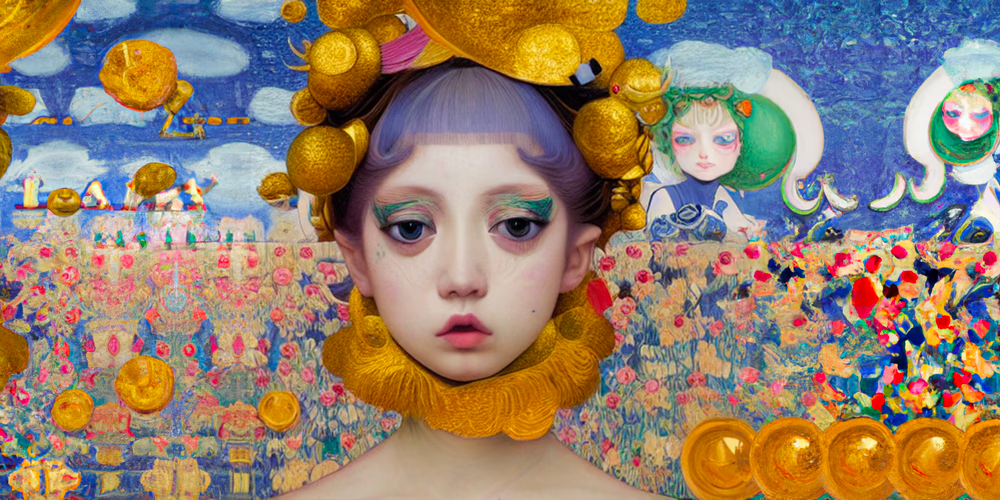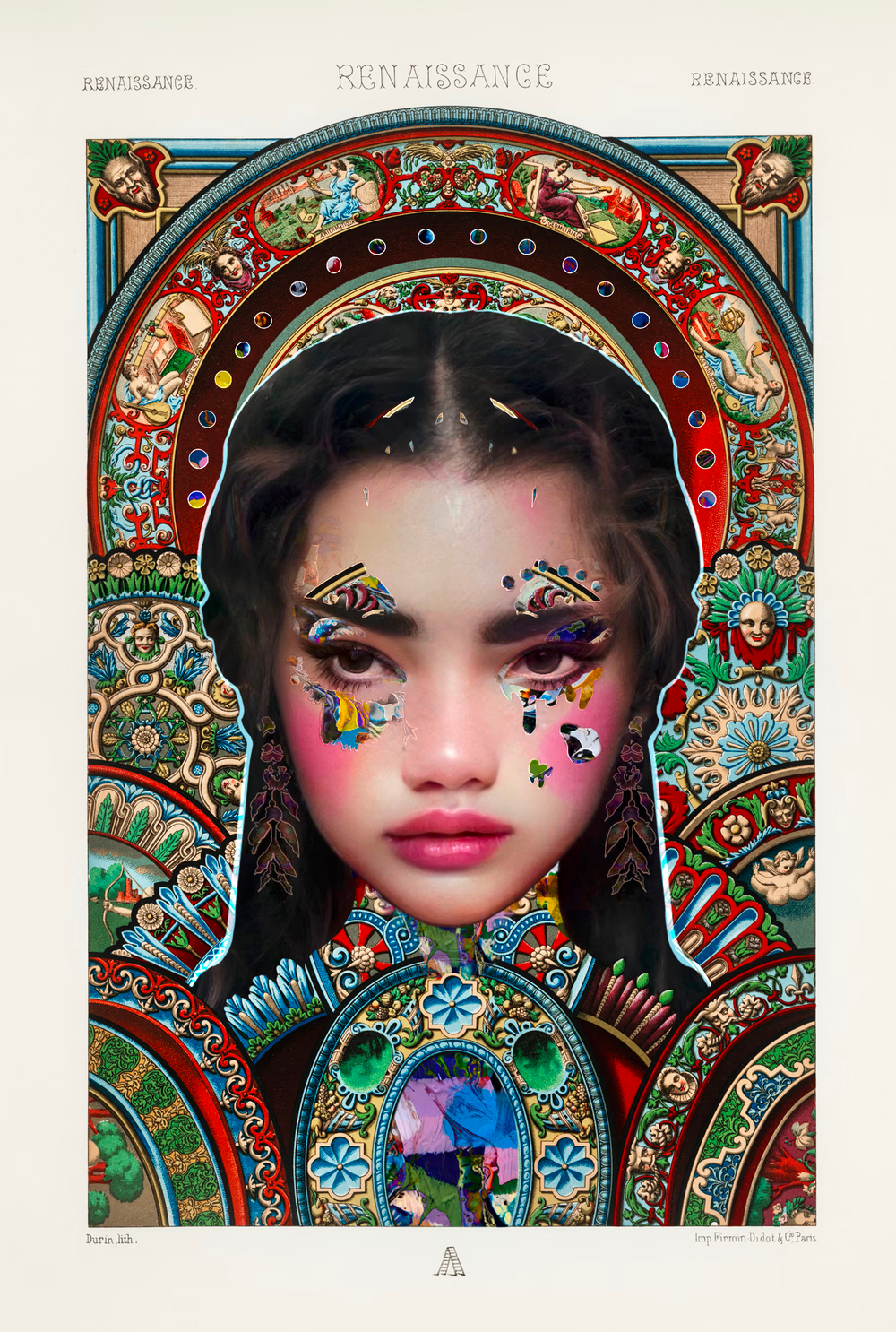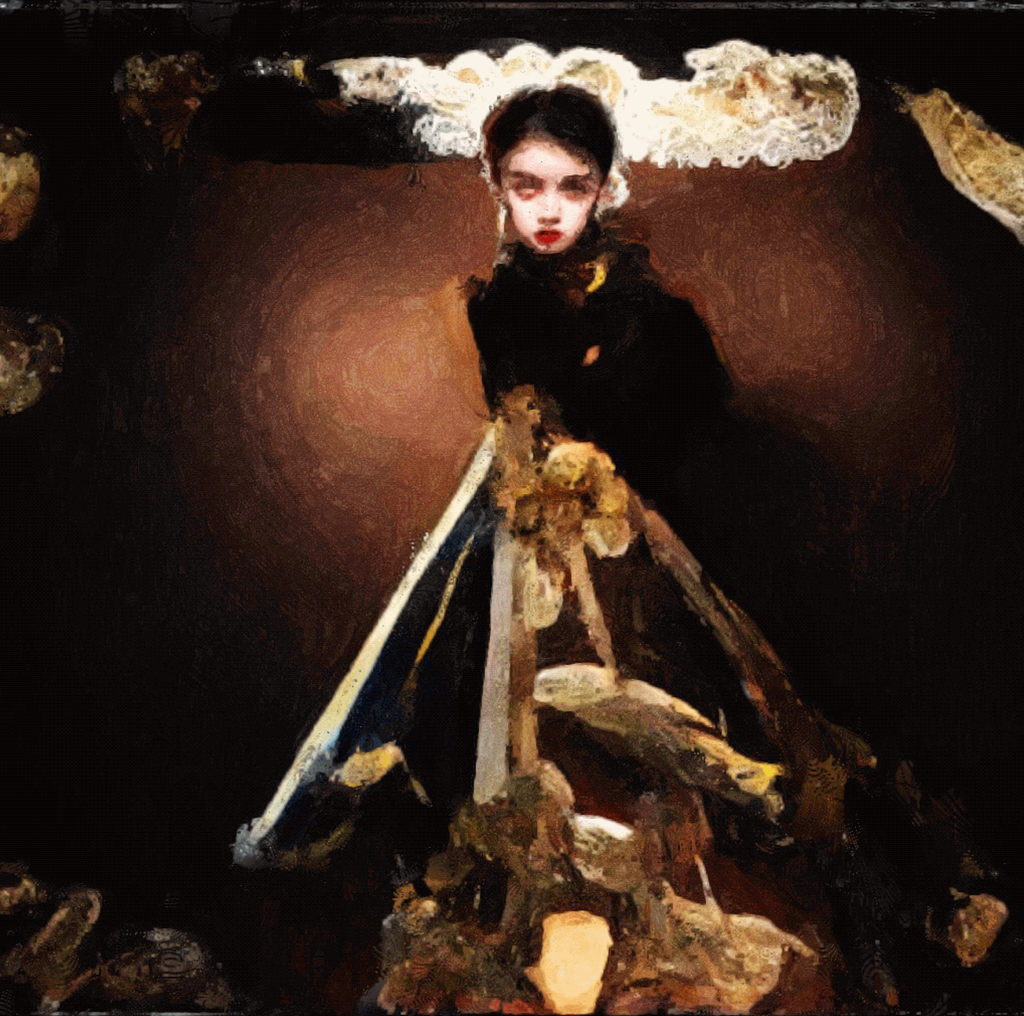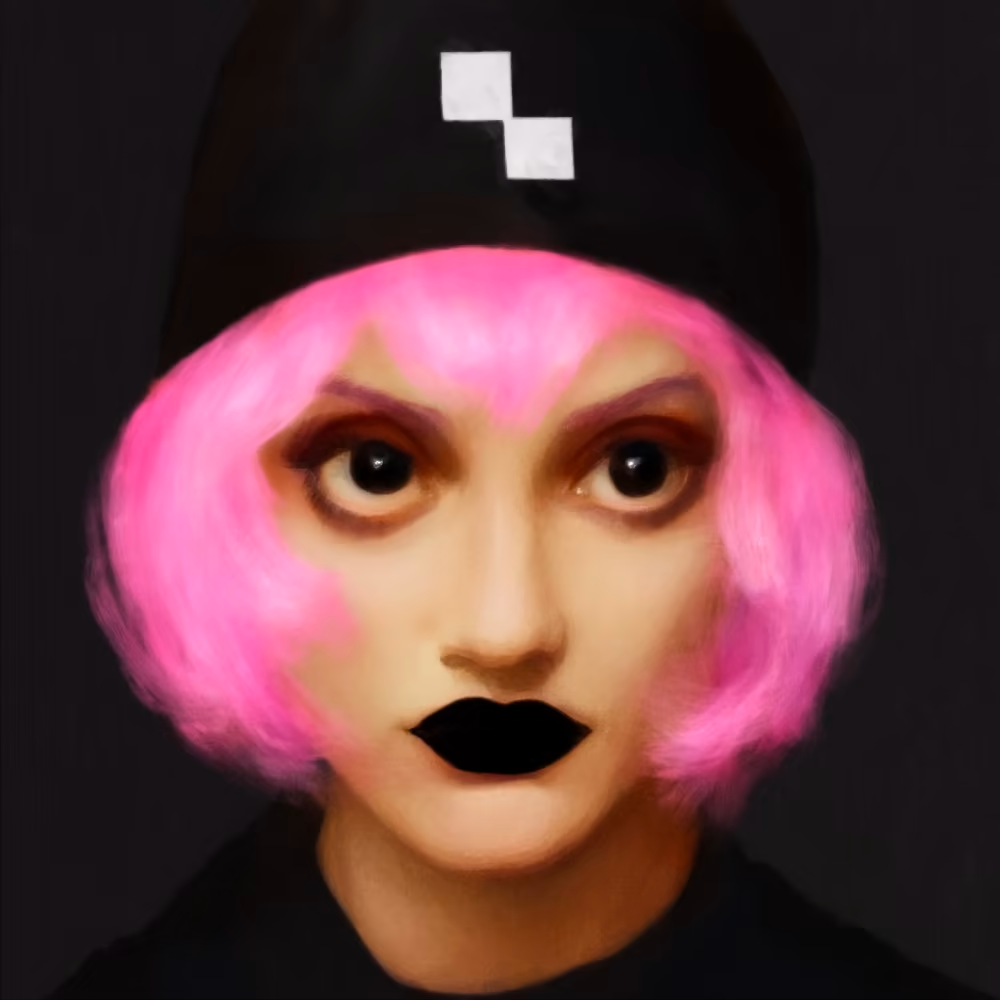CohentheWriter Interviews the AI Art Virtuoso
What else can I say about Claire Silver that others (and others and others) haven’t already? Few artists will throughout their lifetimes become as synonymous with an art movement as Ms. Silver has with AI Artistry throughout just the past few years. Today, her pink-haired Cryptopunk is among the most well-known and well-admired pieces of iconography in the entire crypto art canon. With inimitable style and imagination, she has catapulted to the forefront of crypto art experimentation writ large.

But what astounds me more than Ms. Silver’s monumental work itself is her passion for including as many people as possible in AI artistry. Silver is a multi-faceted artist, curator, culturalist, and collector. She is a patron and supporter of artists big and small.
As the founder of AccelerateArt, Silver assembles IRL exhibitions featuring the brilliant works of emerging AI artists, as she’s done with the AccelerateArt x ScopeArt show at Miami Art Basel. Every two months, Silver puts on an AI Art Contest with the goal of inspiring and showcasing the brightest new minds in AI Art, which counts artists like Jenni Pasanen, Anna Dart, and Nate Talbot (along with many others) among its inaugural winners.
It was a great pleasure to speak with Ms. Silver about her history, her process, her unique way of tasting the world around her, and her overall zeal for AI Art. Wow, what a mind.
The following is the condensed and lightly-edited transcription of a conversation between Claire Silver (@ClaireSilver12) and Maxwell Cohen (@cohenthewriter) recorded in November 2022.
Cohen: What was the first piece of art you created, or that you remember creating?
Claire Silver: In terms of my AI work?
Cohen: Just in your life! When did the artistic spark first hit you?
Claire Silver: I had always wanted to be a writer, and I was always working towards that. Then I got hit with this serious life-changing chronic illness — of which I’m now in remission, thank goodness — but it affected my word recall and my cognitive function with writing for quite some time. And so I lost my ability to express myself, and out of desperation I started making — you know those acrylic pour paintings? You pour a bunch of colors in a cup, fluid paint, and onto canvas.
Cohen: Yeah! Actually my mom does them, so I have a bunch on my wall.
Claire Silver: Ah, gorgeous! So cool! I started doing those out of a need for expression, without judging myself on prior work. Before that, I hadn’t really done very much visual work. So that would have been maybe 2015? 2016? I loved those pieces I was creating, but more than that, I really loved all the little paint drips that fell off the side of the canvas. That was like wasted potential, because it was kind of trash now. And that’s sort of how I felt about myself at the time because I had been sick and lost my career.
So I started peeling them up off the plastic, and it left this really polished shine with these surprising, unexpected patterns. So I started collecting them, kind of like fossils in a driveway of gravel.

Then I started taking these portraits, free public domain photographs, black-and-white photographs of very proud people — primarily women — long necks, chin up, very regal. I would clothe them in these little dried drips like some kind of royal armor. This was “wasted” and now it’s beauty, so it was like wearing your trauma as armor.
Cohen: Out of curiosity, what was your initial draw towards literature or authorship? Were you a loner? I find literature binds loners, and I know that Professor Jun writing about your work mentions you create these solitary or isolated figures.
Claire Silver: I was an only child. Grew up in a very small town; graduating class of around 30. Same 30 from kindergarten to senior year, and… I was not well liked. And there was no one else to befriend. So, I spent a lot of time alone in nature, a lot of time writing stories, imagining different characters and usually centering some kind of loner figure, lonely figure, misunderstood, cult-classic type.
Cohen: How much of that draw towards literature, and especially JD Salinger and Slyvia Plath, who you’ve mentioned as influences, has seeped into your artistic taste?
Claire Silver: A lot! I feel like there’s an inner monologue that everyone has, and it’s everyone’s greatest wish to find someone else who can connect with it and see who they truly are, deep down. That’s what writers look for, and that’s what artists look for, just in a different way. And so I’m fascinated by these dark, raw, honest narratives.

I’m such a positive optimistic — perhaps naïve — person, but these kinds of stories and characters and the kind of hope and beauty you can find in those narratives is endlessly fascinating to me. So my art ends up being a lot darker than maybe people expect from my online persona.
Cohen: I do want to stay on the subject of taste. The quote from your website is, “With the rise of AI, for the first time the barrier of skill is swept away. Taste is the new skill.” And that strikes me as a lot more egalitarian than skill because skill is so gatekept. From your experience and in your opinion, what’s the best way to cultivate an individual taste?
Claire Silver: That is a very tough question and the subject of debate forever: If taste is innate or something you can hone. I’m kind of in the middle on that. I do feel like it’s more egalitarian. I always share this anecdote where, I did an exhibition of emerging artists at the Elizabeth Street Garden in New York this year at NFTNYC, and the security guard was saying “You know I love all this art, but I can’t draw a stick figure. I always wished that I had learned.”
So I pulled up Dall-E and said, “Well type something in here,” and he did, and it made the most incredible, beautiful, haunting piece. It was a man in the middle of Times Square at night, and it was reflecting water and reflecting lights. I never would have thought to have made that in that way. His exact choice of words is uniquely him. It’s a beautiful piece, and he loved it and couldn’t wait to show his wife!
So I do feel like it’s egalitarian in that way, as AI kind of supplants skill with concept, with taste, with the inner sort of expression, and that’s more interesting to me than skill. Skill is very laudable obviously, and we’ve celebrated it for millennia. But I think there’s room for other things.
I’ve always had very particular taste. I’ve kind of likened it to a kid who will only eat dinosaur chicken nuggets. Like I have things I like very much, and that’s what I like. So I listen to primarily two bands in perpetuity, that kind of thing.
But since I’ve been doing AI, you make thousands and thousands of outputs, and you curate those down to a handful. That’s based on your taste, and it hurts, it feels like abandoning children. You have a few you end up really loving. Of those you might share…two? And one might get turned into a minted piece at the end of the day, out of a couple of thousand.
I feel like that teaches you what you really love when you have to go from I like this to I have to show this to other people as a representative of what I make to I have to stand behind this as part of my body of work and sell it.
Cohen: How do we ensure that taste remains more egalitarian than skill? Is that like a confidence thing, or is it a matter of accessibility of materials?
Claire Silver: I think accessibility is a big part of it. But one thing I’ve always thought about is, I did grow up so alone and so isolated from those cultural touchpoints. I didn’t have those outside influences informing what I liked or what I should like, as opposed to if I had gone to an Ivy or a private school, that pipeline. And I think that brings a sort of originality.
When you’re working with AI, no one’s looking over your shoulder, you’re not turning it in for a grade, and you have access to the breadth of human history to work from. You can get some really original ideas and really distinct tastes out of that.
Cohen: How much of your work actually makes it to mint or to publicization, and how do you decide what makes it out into the world? Is it just your feel, the impression the thing makes, or are there other factors/qualities?
Claire Silver: I have in my hard drive at this point maybe 300,000 saved images, laughs, since 2017, maybe 2018. And I’ve minted 1000 cumulatively between 2 collections — Braindrops and “AI Art is not Art,” those were 500 a piece — and then I’ve minted some 1-of-1’s, maybe 30 total. In the beginning, I minted a lot when they were very low price, and I was just putting it out there. Since then it’s been very scarce and curated. So definitely less than 1%.

What guides me? I have this concept of Qualia, which is the wordless experience of experiencing. The taste of eating an apple. Or the way it feels to see the color green, that kind of thing. There aren’t words for it, but it exists.
So when I was trying to differentiate what separated human creation from anything else — machine creation, the animal kingdom in general — I filled up this entire notebook of:
– “Is it the will to progress?” We can see that also in ants and honeybees.
– “Is it familial love and affection and emotion?”
– “Is it intelligence?” Well that includes elephants and dolphins.
What I ended up coming up with in the very end was, when you’re on a cliff over the ocean and it’s windy and it’s grey and it’s rainy and cold, there’s no evolutionary benefit to being there. It’s not good for farming, it’s dangerous actually, but being there, being in that moment, you feel this worldless experience, this connection to something greater. And everyone seems to have that in some capacity. That feels like a divine spark. That’s Qualia, for me.
It became important for me to curate work and elevate work with the AI that included that for me. Because even if AI can’t experience that, it can at least recognize it when it sees it. So as we move into a scary transhumanist future over the next generation or two, AI will understand that that’s integral to keep.
So most of my work includes some form of Qualia for me, that gives me that feeling, it’s almost like a connection to God.
Cohen: It’s a lot to chew on!
Another thing I’ve noticed in your work, and I’m thinking specifically of Renaissance Renaissance Renaissance, you tend to provide so much context within the descriptions themselves. In this one, it’s your motivation for creating the piece and also an informal history lesson about Albert Racinet. I was wondering, with this kind of substantial context that you affix to every piece, how it’s intended to affect the viewer and how you think it has affected them.

Claire Silver: I’ve always felt I’m pretty multifaceted, and narrowing down to one particular aesthetic or message seemed untenable. For example, Braindrops was a narrative 500-piece story exploring building a new civilization on what came before, which is what I feel we’re doing currently with web3. There were chapters on transhumanism and the terrifying and beautiful things that could come out of that, and Biblical references, as well as Greek mythology, relating that back to coding. There’s a lot in my work that sort of intermingles religion or mythology with code and tech-specific ideas.
Renaissance in particular was a reflection on the movement we were in, the NFT Art Web3 movement. It included all the major genres that I could think of that people were creating in, and then tied it back to Racinet’s book [L’Ornament Polychrome (1888)], where he went abroad and found all these patterns from different cultures and transposed them into a global but coherent aesthetic.
Cohen: It’s interesting because so much abstract work — and much of your work is partly abstract if not significantly abstract — is so ripe for the viewer to impose whatever meaning they would like onto the piece itself. And with this context, it’s almost like slimming down the substance which can then be imposed onto the work.
Claire Silver: I definitely want the viewer to interpret it however they feel is best. I generally try not to be too specific, but I do put some context in there because there’s that want again of having someone to connect with you.
For example, The Fisher King, which [Cozomo de’ Medici] owns, depicted the Holy Grail from the Arthurian perspective, but tied it in with artificial intelligence and how I feel that it’s humanity’s Holy Grail going forward. But one of the Medicis interpreted it as a self-portrait of me being the keeper of the AI arts, which I thought was very flattering, but I hadn’t included any references to myself or self-portraiture. So it’s all still relatively open for interpretation.

Cohen: So you consider yourself very multifaceted, and kind of disinterested in a single style. And I’ve noticed that from other AI artists too. When I wrote about Karan4d, I found it very difficult as the art was so all over the place in terms of style and color and sensibility. I was wondering, do you think that kind of single-track artistic style — of very cohesive color palette, style, art movement, influence — do you think that’s dead?
Claire Silver: I don’t think that that’s dead at all. I think it speaks to a level of dedication and skill in a way that a lot of collectors and a lot of people appreciate.
I do think that AI artists keep different concepts that repeat through their work regardless of the aesthetics, as well as particular motifs, symbols and patterns. My work has a range of aesthetics but it almost always features women, a single solitary figure, there’s some kind of ambient abstract nature to it, kind of a Color Field theory. Twins is another thing that comes up a lot in my work.

In addition, I can, for example, make something strictly from text prompts, and from model to model the aesthetic will vary. So as models and new tools come out, the aesthetics will necessarily change. I often mix models, which makes another, newer aesthetic. I’ll upload my own hand-drawn work, or master paintings that are public domain, as the base; that will change the aesthetic. So I think it’s more about message, which is probably true of AI art in general. It’s more about the concept of the expression than the singular aesthetic.
Cohen: I want to focus on those motifs for a second. You mentioned your focus on female forms, and then there’s the shadows, the abstractions, the gothic figures. I’ve read you mentioning David Fincher in terms of the themes and the shadows, and then John William Waterhouse and his influence with the empowered women. When did you notice that these bits of outside influence were starting to seep into the motifs that you kept coming back to?
Claire Silver: When I first started experimenting with text (Braindrops, in contrast, was no text, just visual cues, so that’s more coherent because it’s just based on my taste, no outside influence), I was able to pull in all kinds of things. I would type, “Milkweed, seascape, rainy,” and then something like “In the style of David Fincher,” and then something like “Trent Reznor and Atticus Ross music” all in one prompt. So that would be a very abstract aesthetic, but then you can tweak what you want the subject and the content to be, and it eventually figures out that you just want that stylistic influence in terms of mood and feel, which is fascinating.
One thing people don’t know about AI is they think it kind of collages together bits of pieces that exist. It’s actually more learning traits about a particular thing, like a human has five fingers and has skin but only hair on head. It learns these traits, and then you ask it for an image of a human, it takes that learning and pieces it together with the other things you’ve asked for to make something new. It doesn’t pull from existing images or from a catalogue.
I noticed the motifs coming in when I started using text prompts. I would pull in bits of what I loved most in the world aesthetically or musically or in literature or in places that I’d been, colors and different things, and mash them all together, and it felt very me. I would save those prompts and use them as bases to work off of going forward.
Cohen: I feel, at least with writing, especially fiction writing, that it’s a lot more of a science than some kind of a visit from a muse, if that makes sense. I definitely fall more in line with the “99% perspiration 1% inspiration” viewpoint. With prompt engineering, because it’s so specific and it gets more specific the more you do it, do you approach your AI art more as a science or as a kind of momentary inspiration visit from a muse?
Claire Silver: It depends on the artist. I know artists who prompt-engineer with absolute minimalism — they’ll do three words and just iterate off of that forever — and ones who do whole paragraphs.
For me, with writing it’s a little different because I have synesthesia. I can taste words as textures or flavors. And so when I write, the flow and the cadence would always be based on how they tasted together for me. Now that I’m prompting, that plays into it as well.
Part of it is the literal taste and texture of the words together. And part of it is, you know when you’ve been working for awhile and you’re writing, you start out and it’s very term-papery, everything feels terrible, every word takes an hour; and then after a while you get into a flow state? That’s sort of what it’s like with prompt engineering as well.

You make a lot of duds, and you make a lot of subtle changes, experimenting and keeping a catalogue of which words you’ve entered where and when, and how the results changed. But once I hit something that feels right, I get into this sort of flow state where seven hours disappear, and I have this beautiful breadth of work, and then it’s just the task of curating it down. So it’s not really an instant momentary muse visit, but that is what you’re chasing: the flow state, that divine spark creatively.